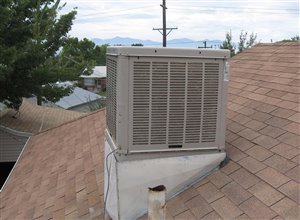If the heat transfers from the air to the evaporated water and the evaporate is expelled with the cooled air, the heat being expelled should end up being the same.
However, wouldn't the heat be released back to the air when the vapour condenses on surrounding surfaces reheating the room?
Johno12345:
they don't work over here as the climate isn't dry enough
I am inclined to agree. Leaving aside any cooling of the exhausted air, the motor will heat the room.
Heat from the incoming air is lost as the latent heat of evaporation of the water, but when the water in the air condenses, the heat is given back. If the walls are sufficiently porous, the moisture may travel through and be evaporated by the surrounding dry air; but if it condenses within the room, nothing has been gained.
ETA: it may be that in the short term, the air within the room is cooled and the walls are warmed, but this will soon even out.

We're about to take you to the IET registration website. Don't worry though, you'll be sent straight back to the community after completing the registration.
Continue to the IET registration site